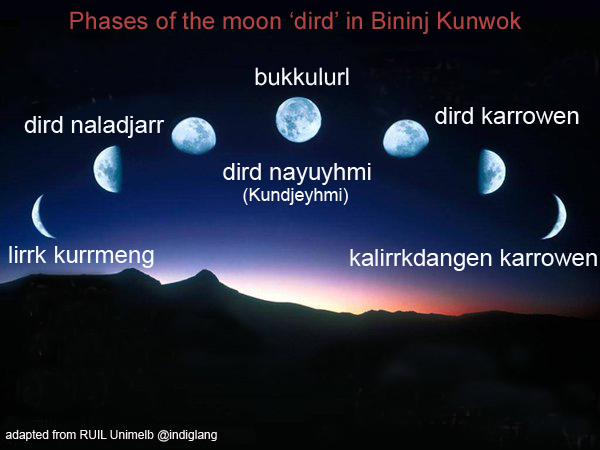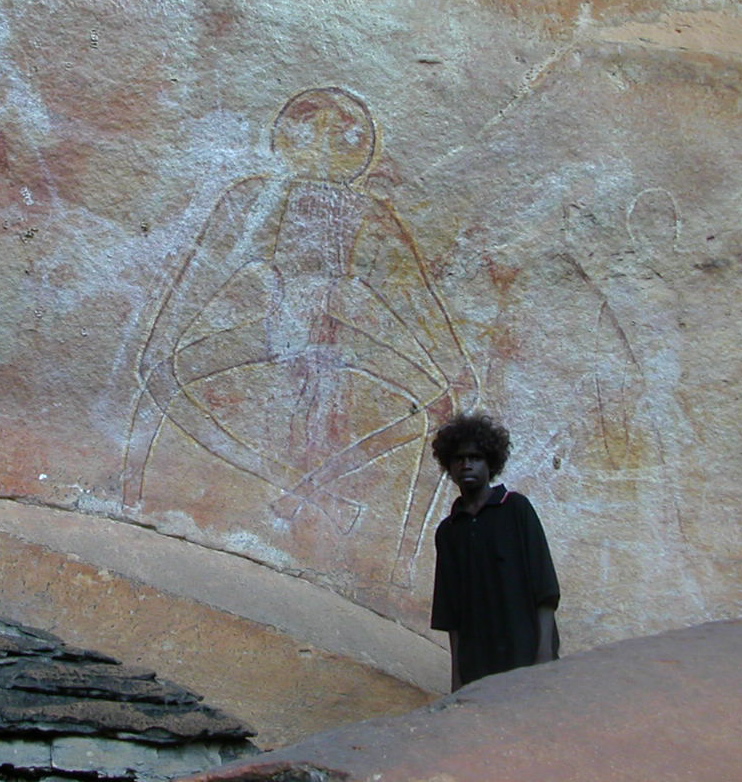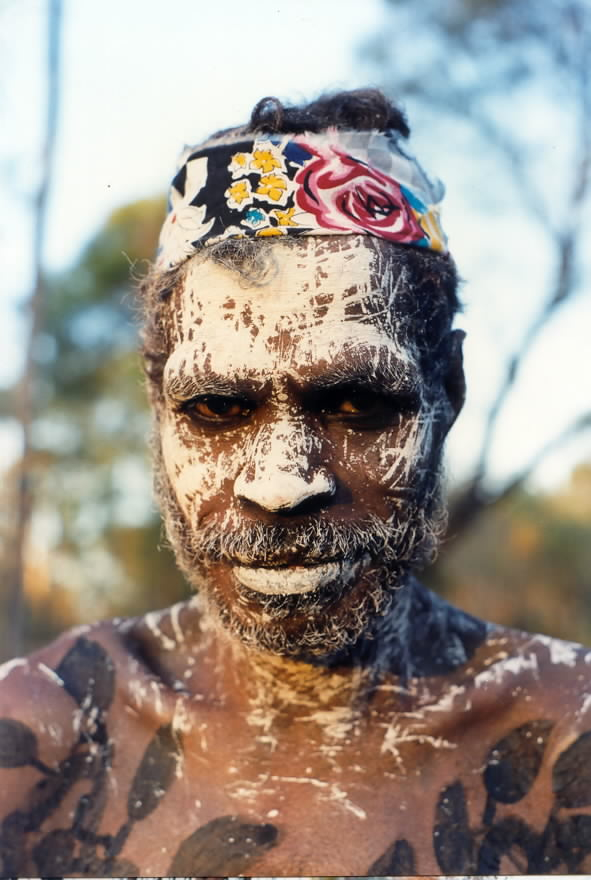Mandjurlukkumarlba
Dird 'the moon'
The Research Unit for Indigenous Languages at the University of Melbourne recently tweeted a nice graphic with various names for the moon in a number of Australian Indigenous languages. Here is their same graphic background reworked with names for phases of the moon in Bininj Kunwok:
In Bininj Kunwok dialects ome people call the moon dird and some say karrakbarl. There is an important story about the moon involving two characters, the moon and the quoll. In their human forms in the creation period or 'the dreaming' as some English speakers call it, they both fought over the fate of humanity. The quoll said that when people die, they should die forever and not return to earth but the moon disagreed. As they could not resolve their differences, the moon said he would leave the earth and live in the sky where he could live through a monthly cycle, die, and then return again for another cycle. The quoll stayed on earth and introduced death and so now all humans die but the moon is reborn each month. This is why a waning moon is said to be 'dying' or dird karrowen [moon it-dies] in Bininj Kunwok. In sign language, the hand sign for the quoll is the same as that used for wayarra 'spirit of a dead person' or 'death'. A beautiful and famous image of the moon spirit with his long arms and long penis is depicted at Ngalurdbirrhmi. The picture below depicts this image with Obed Wurrkkidj standing in front.
Obed Wurrkkidj at Ngalurdbirrhmi. © Bininj Kunwok Language Project
The most noticeable difference between English and Bininj Kunwok terms for phases concerns the new moon. A new moon in English is announced before any crescent is visible, i.e. on the night when the whole moon in dark. In Bininj Kunwok the very first thin crescent is called lirrk and when that first thin crescent does appear it is said that 'it [the moon] has put lirrk [the first crescent]'. The opposite term, when the last waning crescent is visible, the term is:
kalirrkdangen karrowen 'the crescent stands and is dying'
ka-lirrk-dangen ka-rrowe-n
it-crescent-stands it-die-non-past
The full moon is called either bukkulurl or dird nayuyhmi.
The word for moon is also the word for month, these two concepts being closely related or the same word in many languages of the world.
You can hear the pronunciation of the word dird by clicking here.
Bonj
That is all.
Kabarung
Balang Djimarr Kebbarurrinj
In this post we will learn the verb -barung 'to cover in paint or ochre, to smear'.
In this picture Balang Djimarr (a speaker of Kuninjku) has painted his body and face. His body has a plant design painted in black ochre. This plant is called wurrurrumi in Kuninjku which is a vine that botanists call Tinospora smilacina. This is also the name of a song series that Djimarr sings. That's why he has that design painted on his body. On his face he has white ochre or delek splattered in a design known as bedjek-bedjek.
The verb -barung means to cover with paint or ochre or to smear a surface with some liquid or viscous substance (like paint, glue, oil etc). There is another verb -bimbun which means to draw, write or paint an image. This has a different meaning to -barung which means to smear, cover a surface with paint, ochre or some other similar substance.
Here are some examples of the verb with a few different pronoun prefixes:
nga-barung 'I smear it'
yi-barung 'you smear it'
karri-barung 'we are (all) smearing it'
kabirri-barung 'they are smearing it'
You can incorporate a noun into the verb, between the pronoun prefix and the verb. The word kun-keb means 'nose/face' but when it gets incorporated into the verb you drop off the noun class prefix kun- like this:
kabi-kebbarung 'he is painting/smearing his (another person's) face'. In this example, the prefix kabi-means 'he/she acting on another single person' (third person singular subject acting on a third person singular object). If you wanted to say he/she is painting their faces you would use:
kaben-kebbarung
The prefix kaben- means that a single person is acting on a plural (three or more) object i.e. 'he/she acting on them'.
If you are painting your own face, then you need to use the reflexive form of the verb which is -barurren [baru-rr-en]. This is the present or future tense form. In the past tense the reflexive is -barurrinj.
If I want to say 'he painted his face' then in the third person singular past tense, there is no prefix on the verb. It is what linguists call a zero prefix. We need to keep the noun 'face' incorporated however so we end up with this:
kebbarurrinj
ø- keb- baru- rr- inj
3sg.past-face-smear-reflexive-past
Then we can change the "mood" to an event that is not real, i.e. something that didn't happen, or what is known as "irrealis mood". This form of the verb occurs with the negative marker minj 'not'. If you wanted to say 'she didn't smear/cover it with paint' you would say:
minj baruyi
But if Balang didn't paint his face with the ochre in the above picture, you would say this:
Balang minj kebbarurremeninj.
Balang did not paint/smear his/her (own) face.
Bonj
That is all.
Bush-waken Man-me
Darth Vader ka-wokdi Kunwinjku
Darth Vader ka-wokdi Kunwinjku!
See here for more discussion about the pronouns in other languages:
http://allthingslinguistic.com/post/118149053875/i-am-your-father-in-20-different-languages
Bornang! 'I am your father'
In Kunwinjku you just say it in one word bornang ‘I am your father’ (literally: 'I>you fathered'). The subject and object marking is by zero prefix (i.e. nothing) ‘first singular acting on second singular’ on the kinship verb -bornan ‘to father OBJECT’. In past perfective you change the final alveolar nasal to a velar ø-borna-ng ‘I>you father PP’. In light of the above discussion about pragmatics (follow the link above) however, you could add the free standing first person pronoun ngaye for emphasis so that ngaye bornang “Me, I fathered you”.
nga-bornang 'I fathered him/her' > I am his/her father
ngan-bornang 'he fathered me' > he is my father
ngun-bornang 'he fathered you' > he is your father
yi-bornang 'you fathered him/her' > you are his/her father
kan-bornang 'you fathered me' > you are my father
bornang 'I fathered you.' > I am your father
But a woman can also use this verb to talk about the children of her brothers because she too as father's sister 'fathered them'.
bonj
that is all





